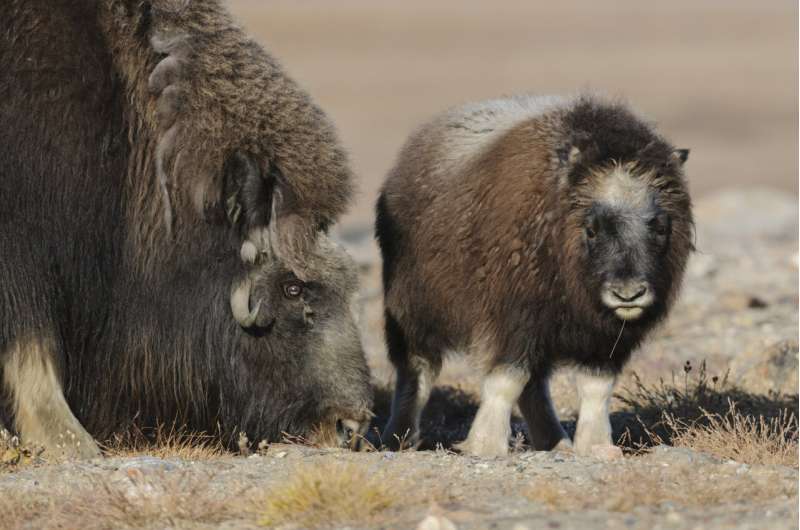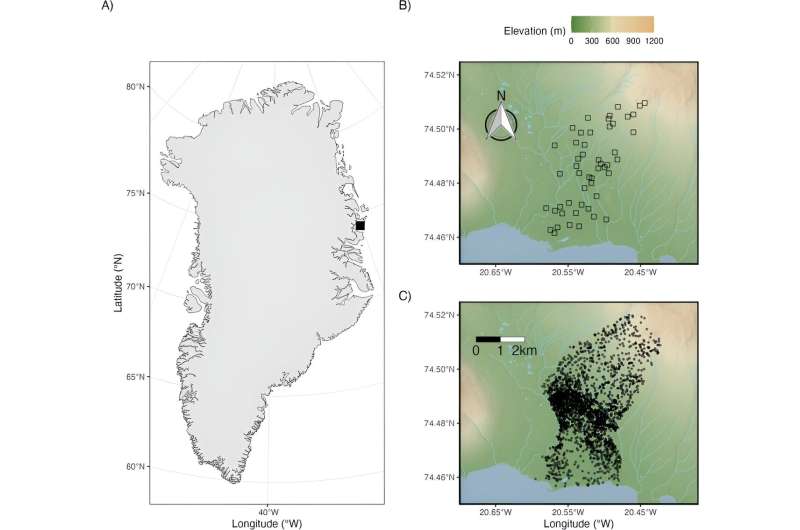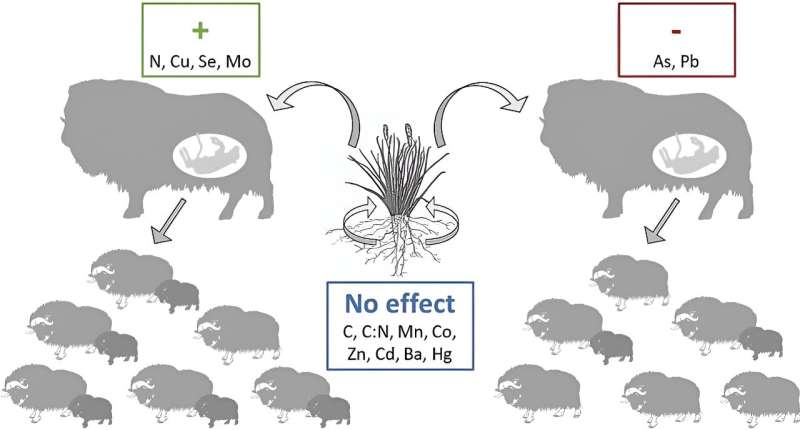This article has been reviewed according to Science X's editorial process and policies. Editors have highlighted the following attributes while ensuring the content's credibility:
fact-checked
peer-reviewed publication
trusted source
proofread
Research finds geochemical landscape drives musk oxen reproductive success

Researchers have studied Greenland musk oxen that have been followed for 25 years to see how their feeding habits affect their reproductive success. And it turns out that when they go to areas with more copper and selenium in the ground, they have more calves.
One of the researchers behind the new study, senior researcher Floris M. van Beest from the Department of Ecoscience at Aarhus University, explains why the results are important for our understanding of wild animals.
"Usually, researchers look at the quality of the plants that the animals forage on. They measure major components of the plants, such as nitrogen. But we dig a little deeper. We look at trace elements such as copper and selenium in the plants, but also if they are present in the ground beneath the plants."
The study is published in the journal Science of The Total Environment.
First study of its kind
The study is the first time that the chemical composition of the ground has been coupled with the reproductive success in animals.
Because of better technology for measuring very low concentrations of these elements, it's now possible to do these kinds of studies, explains Sophia V. Hansson, a researcher at the Centre National de la Recherche Scientifique in Toulouse, France. She's also one of the researchers behind the study.

"From a geochemical perspective, it's interesting to look at essential and non-essential elements together. Usually, studies tend to focus on the pollutants or the major elements like carbon and nitrogen, but here we look at the essential smaller components—trace elements such as copper and selenium—as well."
"Thanks to technological improvements, we can now detect even very low concentrations of such elements. Better than we could 10 years ago."
She hopes that this study is only the first in a long line of similar research projects mapping the chemical composition of the ground and the effect it has on animals.
"It's a truly interdisciplinary study, combining chemistry, geology, and ecology, and I hope that the approach will be used in other areas as well. Here, we've only mapped 25 square kilometers of Greenland, but much more of the arctic area could be mapped in a similar way," she says.
So, how did the researchers show how the chemistry of the ground affects the reproductive success of the musk oxen?
To do so, they needed four sets of data. They needed to know where the musk oxen were at different times. They needed to know the number of animals and how the population expanded or decreased over time. They needed to know which plants were abundant in the different areas. And they needed to know the chemical composition of the ground and the plants.
Luckily, the musk oxen in Greenland have been studied closely for the last 25 years. Some of the animals have GPS trackers on them, allowing the researchers to know where the animals go to forage. Also, every summer, a field crew of researchers perform visual counts of all the musk oxen they find in the area and make a note of how many adults, males, females, and calves they see.
The data from 25 years of studying musk oxen were then paired with maps created from the chemical composition of vegetation and soil samples gathered at 50 different spots.

Bad chemicals on the tundra
Not all the areas in the tundra of southern Greenland where the musk oxen feed are filled with good chemicals. The researchers also found areas where higher levels of contaminants such as arsenic and lead were present.
And that is not a good thing for the oxen; Floris M. van Beest explains, "In some areas, we found arsenic and lead, and we know that it can reduce the reproductive success of the musk oxen. However, we did not find a causal effect here. Normally, it would cause the reproductive organs to collapse, but there are still musk oxen present, so somehow they found a way to survive."
Typically, contaminants such as lead and arsenic are more concentrated in the heathlands further up the mountains. Normally, the musk oxen prefer to stay in the valleys, foraging on grass and dwarf willow. But not always. "We can see that the reproductive success of the musk oxen is higher when they stay in the valleys and eat grass. When they migrate into the mountains and forage on heathlands, they have fewer calves," he says.
This applies to other animals as well
Even though the results only cover musk oxen in Greenland, both Floris M. van Beest and Sophia V. Hansson stress that other animals must be affected by the chemistry of the ground in a similar manner.
"We don't know much about how this works in the wild. But from veterinarians and zoos, we do know something. They have given animals supplemental food for a long time and know some of the effects. But, of course, it's different for wild animals," Sophia V. Hansson says.
The next step would be to study other animals and other areas with different chemical compositions in the ground.
"Not every animal needs the same amount of elements. But you can use the approach in other areas. Now we know a little more about how these elements are spread through the ecosystem and how they affect the animals. The next step would be to use the same approach to map out other areas in Europe," Floris M. van Beest says.
More information: Floris M. van Beest et al, Geochemical landscapes as drivers of wildlife reproductive success: Insights from a high-Arctic ecosystem, Science of The Total Environment (2023). DOI: 10.1016/j.scitotenv.2023.166567
Journal information: Science of the Total Environment
Provided by Aarhus University





















